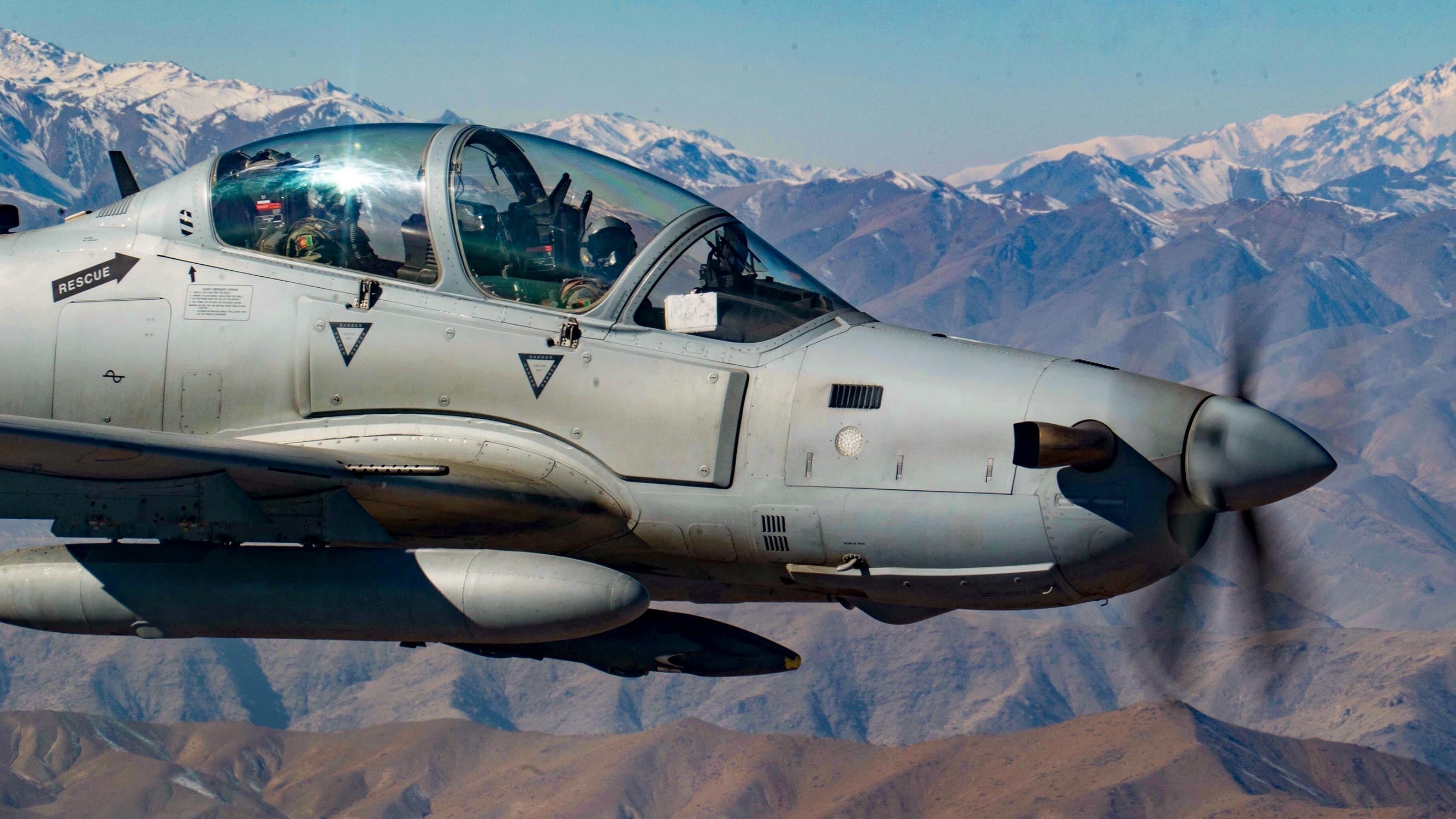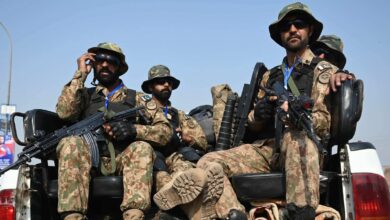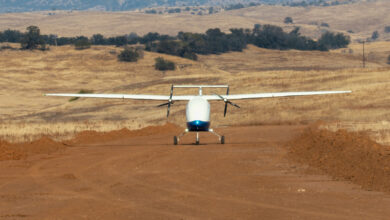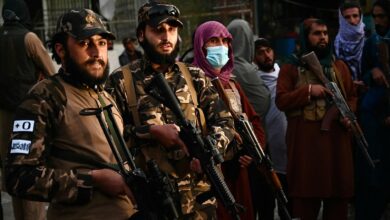Sierra Nevada awarded 5-year Afghanistan A-29 training contract as US shifts to in-country instruction
Sierra Nevada was awarded an almost $43 million contract for A-29 Super Tucano light attack aircraft training for the Afghan Air Force, the Department of Defense said, as the U.S. transitions to a fully operational training program in Afghanistan by 2021.
The $42,722,019 indefinite-delivery/indefinite-quantity contract (FA3002-19-D-A003) provides for training Afghanistan Air Force A-29 pilots and maintainers at Moody Air Force Base in the U.S. state of Georgia and in Afghanistan, the Thursday, April 4 release said.
The contract is funded from fiscal year 2019 building partner capacity/pseudo-foreign military sales funds, and work is expected to be completed by December 31, 2023.
U.S. A-29s are built in Jacksonville, Florida in a partnership between Sierra Nevada Corporation and Brazil’s Embraer, the designer of the aircraft.
A durable and flexible two-seat aircraft designed for counter-insurgency and close air support roles, the A-29 Super Tucano can also be used for reconnaissance missions in low-threat environments and for pilot training.
Powered by a variant of the world’s most popular turboprop engine – the Pratt & Whitney Canada PT 6 – rather than a jet, the A-29 is capable of operating from unimproved runways.
The aircraft can be equipped with advanced avionics, an electro-optical, infrared and laser targeting system, as well as communications and datalinks to enhance its combat capability.
The Super Tucano is relatively cheap to buy, fly and maintain, costing from around $18 million each depending on configuration and about $1,000 per flying hour, according to The Diplomat. According to SIGAR’s July 2018 report, the unit cost of aircraft supplied to Afghanistan was $27 million.

Afghanistan Air Force A-29s
After a 2011 contract was cancelled, Embraer and Sierra Nevada Corporation were awarded a $427 million delivery order to an indefinite-delivery/indefinite-quantity contract in February 2013 to supply 20 A-29s plus training devices and other equipment for allied countries under the Building Partnership Capacity program.
One of the A-29s produced under that contract for the Afghan Air Force crashed during training in March 2017.
The U.S. Air Force ordered six additional A-29s for the Afghan Air Force in October 2017. Two of those aircraft were delivered to Moody AFB last April.
In September 2018, Sierra Nevada was awarded a potential $1.8 billion contract for procurement, sustainment, modifications, and equipment for A-29s for the Afghan Air Force. Work will be performed at Moody AFB, and at Kabul, Kandahar, and Mazar-e-Sharif Air Bases in Afghanistan, and is expected to be completed by December 31, 2024.
In its 42nd quarterly report to the U.S. Congress published on January 30, the Special Inspector General for Afghanistan Reconstruction noted that 12 A-29 light attack aircraft were in Afghanistan, but one was unavailable. The aircraft was “severely damaged during battle but was deemed reparable,” according to December data. It is unclear when the aircraft was damaged, but all 12 A-29s in Afghanistan were available in September, according the the previous quarterly report released on October 30.
SIGAR noted that nine more AAF aircraft were in the U.S. for training, and that the “final four A-29s to be delivered to the AAF” were scheduled to arrive at Moody by March 2019.

Afghan Air Force develops A-29 capability
The 81st Fighter Squadron was established in October 2014 at Moody AFB train AAF A-29 pilots, and a program was designed to produce 30 pilots and 90 maintainers by December 2018.
Training began in February 2015, and the A-29 flew its first combat mission in Afghanistan in April 2016.
By August 2017, 17 pilots and 48 maintainers had been trained at Moody and returned to Afghanistan. The Secretary of the Air Force approved the extension of the training program to the end of 2020, based on “requirements for nine more pilots and 20 maintainers.”
In November 2017, Afghan Air Force A-29s conducted the first strike in Operation Jagged Knife, the new campaign against Taliban drug production facilities.
In March 2018, a GBU-58 laser-guided bomb was deployed against a Taliban target in western Afghanistan, the first time an Afghan Air Force A-29 has used a laser-guided bomb in combat. The Pentagon’s “Enhancing Security and Stability in Afghanistan” semi-annual report to Congress published in December 2018 noted that this was the first airstrike executed using Afghan Tactical Air Coordinators to direct a laser-guided bomb dropped by an A-29 pilot.
By April 2018, Afghan Air Force Super Tucanos were conducting one third of all airstrikes, five of the 15 carried out in the country each day, the Afghan defense ministry said at the time.
The December 2018 Pentagon report further noted that “A-29 pilots continue to achieve high accuracy with unguided bombs,” but the AAF was increasingly using precision munitions. “Afghan A-29 pilots are becoming more precise, with over 88 percent of their laser-guided munitions landing within one meter of their target,” the report said.
“This increased accuracy is contributing to the prevention of civilian casualties,” it added, noting that “A-29 pilots continue to show disciplined restraint in not dropping munitions on targets with ambiguous parameters or the possibility of civilian casualties.”

A-29 pilot and maintainer training
As of December 2018, 15 Command Pilots and eight Aircrew (which includes loadmasters, flight engineers, and special mission operators) were available, the January SIGAR report said.
“The projected, full A-29 fleet will require 38 pilots,” it said, adding that Train, Advise, Assist Command-Air “expects there will be 34 qualified pilots by the end of 2020.”
According to the quarterly report from the Lead Inspector General for Operation Freedom’s Sentinel for the period to December 31, U.S. Forces-Afghanistan said the A-29 pilot training program at Moody is training a sufficient number of pilots, and “continued pilot production will depend on full program resourcing as it transfers to Afghanistan by 2021.”

All A-29 initial qualification and mission-qualification training is completed at Moody, according to SIGAR, but “familiarization with Afghanistan’s environmental hazards that are not duplicable in U.S. training environments” and qualification training is conducted at Kabul Airfield including basic surface-attack and close-air-attack training.
The DoD report noted that all A-29 pilot and maintainer students receive their training in the U.S. but due to “continued absconding by up to 20 percent of these students, DoD is shifting all of this training to OCONUS [outside the continental U.S.] locations and is working with the MoD to improve security of pilots.”
“TAAC-Air projects the first shared Afghanistan-based mission qualification training program to start in November 2019, and a fully operational training program will start in country in January 2021,” the SIGAR report said.
The AAF aircraft have had night sortie capability since they were first delivered, but the first night missions were conducted by Afghan A-29 pilots in December, SNC vice-president Taco Gilbert told Jane’s. Munitions were deployed during those missions, Gilbert said. The DoD report confirmed that the night strike was conducted on December 8.
According to the SIGAR report, “2.5 night-employment qualified crews … have recently been employed in night combat missions,” and 11.5 night employment crews are expected to be qualified by the end of 2019.
“Future night training is likely to be conducted at Kandahar and Mazar-e Sharif airfields (once the latter has the lighting capability),” the report said.
Mazar-e Sharif is planned to be the center focus for training, while Kandahar and Kabul will be used for combat missions.

As of November 26, 2018, 51 trained and fully mission-capable A-29 maintainers were assigned to Kabul airfield, 100% of the authorized strength. 23 out of the authorized 55 were at Kandahar. The projected authorizations for 2023 were 51 at Kabul, 57 at Kandahar and 76 at Mazar-e Sharif, but the A-29 program is not projected to have the required number of qualified maintainers until the end of 2024,” SIGAR said.
However, the LIG-OFC report noted that the proportion maintenance performed by Afghans on A-29s was falling, from 40% in April to 30% in December, but referencing the Pentagon report it said that share may vary “based on operational tempo, phased maintenance, and the complexity of maintenance tasks.”
But the Pentagon report highlighted an ongoing issue for the training of Afghan pilots and maintainers – language. Afghans must first learn English before undertaking training.
While noting that pilot and maintainer training continues to progress, it noted that it was “constrained only by the number of English language classes available to potential recruits.”
“Force protection requirements for English language instructors and classes limit the number of opportunities available to candidates and challenge RS advisors to keep enough personnel in the training pipeline to meet ANDSF Roadmap milestones,” the report said.











